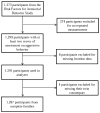Environmental Determinants of Aggression in Adolescents: Role of Urban Neighborhood Greenspace
- PMID: 27343886
- PMCID: PMC4924128
- DOI: 10.1016/j.jaac.2016.05.002
Environmental Determinants of Aggression in Adolescents: Role of Urban Neighborhood Greenspace
Abstract
Objective: Neighborhood greenspace improves mental health of urban-dwelling populations, but its putative neurobehavioral benefits in adolescents remain unclear. We conducted a prospective study on urban-dwelling adolescents to examine the association between greenspace in residential neighborhood and aggressive behaviors.
Method: Participants (n = 1,287) of the Risk Factors for Antisocial Behavior Study, a multi-ethnic cohort of twins and triplets born in 1990 to 1995 and living in Southern California, were examined in 2000 to 2012 (aged 9-18 years) with repeated assessments of their aggressive behaviors by the parent-reported Child Behavior Checklist. Normalized Difference Vegetation Index (NDVI) derived from satellite imagery was used as a proxy for residential neighborhood greenspace aggregated over various spatiotemporal scales before each assessment. Multilevel mixed-effects models were used to estimate the effects of greenspace on aggressive behaviors, adjusting for within-family/within-individual correlations and other potential confounders.
Results: Both short-term (1- to 6-month) and long-term (1- to 3-year) exposures to greenspace within 1,000 meters surrounding residences were associated with reduced aggressive behaviors. The benefit of increasing vegetation over the range (∼0.12 in NDVI) commonly seen in urban environments was equivalent to approximately 2 to 2.5 years of behavioral maturation. Sociodemographic factors (e.g., age, gender, race/ethnicity, and socioeconomic status) and neighborhood quality did not confound or modify these associations, and the benefits remained after accounting for temperature.
Conclusion: Our novel findings support the benefits of neighborhood greenspace in reducing aggressive behaviors of urban-dwelling adolescents. Community-based interventions are needed to determine the efficacy of greenspace as a preemptive strategy to reduce aggressive behaviors in urban environments.
Keywords: adolescents; aggression; environment; epidemiology; greenspace.
Copyright © 2016 American Academy of Child and Adolescent Psychiatry. Published by Elsevier Inc. All rights reserved.
Figures


Comment in
-
It Takes a (Green) Village ….J Am Acad Child Adolesc Psychiatry. 2016 Jul;55(7):540-1. doi: 10.1016/j.jaac.2016.05.004. J Am Acad Child Adolesc Psychiatry. 2016. PMID: 27343880 No abstract available.
Similar articles
-
Increased urban greenspace in childhood associated with lower inattention deficit among adolescents.Soc Psychiatry Psychiatr Epidemiol. 2024 Jun;59(6):947-956. doi: 10.1007/s00127-023-02575-0. Epub 2023 Oct 14. Soc Psychiatry Psychiatr Epidemiol. 2024. PMID: 37837487
-
Individual and Neighborhood Level Predictors of Children's Exposure to Residential Greenspace.J Urban Health. 2024 Apr;101(2):349-363. doi: 10.1007/s11524-024-00829-z. Epub 2024 Mar 14. J Urban Health. 2024. PMID: 38485845 Free PMC article.
-
Residential Greenspace in Childhood Reduces Risk of Pediatric Inflammatory Bowel Disease: A Population-Based Cohort Study.Am J Gastroenterol. 2021 Feb 1;116(2):347-353. doi: 10.14309/ajg.0000000000000990. Am J Gastroenterol. 2021. PMID: 33038129
-
Greenspace and Atopic Sensitization in Children and Adolescents-A Systematic Review.Int J Environ Res Public Health. 2018 Nov 13;15(11):2539. doi: 10.3390/ijerph15112539. Int J Environ Res Public Health. 2018. PMID: 30428525 Free PMC article.
-
Spatiotemporal Variability of Urban Greenspace and Surface Temperature in Dhaka City: A Public Health Aspect.2023 Jul 1. In: Biloria N, Sebag G, Robertson H, editors. The Empathic City: An Urban Health and Wellbeing Perspective [Internet]. Cham (CH): Springer; 2023. Chapter 7. 2023 Jul 1. In: Biloria N, Sebag G, Robertson H, editors. The Empathic City: An Urban Health and Wellbeing Perspective [Internet]. Cham (CH): Springer; 2023. Chapter 7. PMID: 38091465 Free Books & Documents. Review.
Cited by
-
The Effect of a Theory-Based Educational Intervention on Reducing Aggressive Behavior among Male Students: A Randomized Controlled Trial Study.Biomed Res Int. 2022 Aug 23;2022:6308929. doi: 10.1155/2022/6308929. eCollection 2022. Biomed Res Int. 2022. PMID: 36051482 Free PMC article. Clinical Trial.
-
Residents' awareness of the role of informal green spaces in a post-industrial city, with a focus on regulating services and urban adaptation potential.Sustain Cities Soc. 2020 Aug;59:102236. doi: 10.1016/j.scs.2020.102236. Epub 2020 May 8. Sustain Cities Soc. 2020. PMID: 32395422 Free PMC article.
-
The relationship between surrounding greenness in childhood and adolescence and depressive symptoms in adolescence and early adulthood.Ann Epidemiol. 2018 Apr;28(4):213-219. doi: 10.1016/j.annepidem.2018.01.009. Epub 2018 Feb 2. Ann Epidemiol. 2018. PMID: 29426730 Free PMC article.
-
Urban Green Space and Its Impact on Human Health.Int J Environ Res Public Health. 2018 Mar 3;15(3):445. doi: 10.3390/ijerph15030445. Int J Environ Res Public Health. 2018. PMID: 29510520 Free PMC article. Review.
-
Associations between neighborhood built, social, or toxicant conditions and child externalizing behaviors in the Detroit metro area: a cross-sectional study of the neighborhood 'exposome'.BMC Public Health. 2022 May 28;22(1):1064. doi: 10.1186/s12889-022-13442-z. BMC Public Health. 2022. PMID: 35643553 Free PMC article.
References
-
- Krug EG, Dahlberg LL, Mercy JAM, Zwi AB, Lozano R. World report on violence and health. Geneva: World Health Organization; 2002.
-
- Anthony D. The state of the world’s children 2012: children in an urban world. New York: United Nations Children’s Fund (UNICEF); 2012.
-
- Wandersman A, Nation M. Urban neighborhoods and mental health: Psychological contributions to understanding toxicity, resilience, and interventions. American Psychologist. 1998;53:647–656. - PubMed
-
- United Nations, Department of Economic and Social Affairs, Population Division. World Urbanization Prospects: The 2014 Revision, (ST/ESA/SER.A/366) New York: United Nations; 2015.
-
- Liu J, Wuerker A. Biosocial bases of aggressive and violent behavior--implications for nursing studies. Int J Nurs Stud. 2005;42:229–241. - PubMed
Publication types
MeSH terms
Grants and funding
LinkOut - more resources
Full Text Sources
Other Literature Sources
Medical

